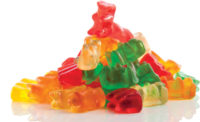Researchers from Ozyegin University and Middle East Technical University have been experimenting with how changing key parts of the gummy-making process affects the final product, as well as how the gummies behave in different storage temperatures. They used these results to identify the most shelf-stable combination for gummy candies. Their article is published in Physics of Fluids.
To address these questions, the group changed a variety of inputs while making the gummies, from the glucose syrup-to-sucrose ratio to starch and gelatin concentrations. They wanted to understand how these changes affected features like candy texture, moisture content, and pH.
They then studied the resulting features of the candies before and after storage. Storage conditions varied from 10°C to 30°C for 12 weeks or 15°C to 22°C for a year.
"A high number of parameters was the main challenge in our study," author Suzan Tireki said. "We had eight different candy formulations, four different temperature conditions, and two different storage times. Another challenge was to try to find a common model for all these eight formulations, as each of them behaved differently."
To account for such a variety of variables, the researchers used a statistical model to describe how each combination affected the quality parameters of the gummy. They explored the chemical crosslink distances, or the length of bonds between molecules in the candy.
"The most innovative part of our study was investigating the texture of the gummy candies by estimating the average crosslink distances using the hardness data coming from texture profile analysis," Tireki said.
"Our most surprising finding was that hardness and average crosslink distance were not affected by the amount of starch," she said.
Read the full article here.
Original article: Exploring the physics of gummy candy, phys.org.









